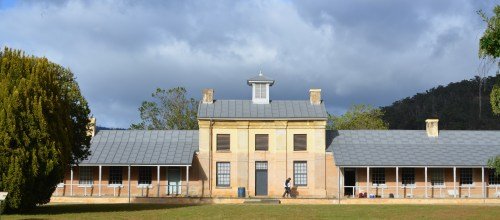
Willow Court Barracks. Photo credit: Ian Edmondson
Reading Buildings
By Ian Edmondson, Graduate Diploma in Archaeology and Heritage Management student.
The Willow Court complex is architecturally confounding, an eclectic mismatch of buildings liberally scattered over a broad acreage. The observer is engaged initially by a confusing array of architectural styles. Buildings have been adapted, altered or added in response to changes in (mostly European) architectural trends (Georgian, Victorian, Gothic Revival, Art Deco) with varying functional and stylistic features. Changes in use, evolving beliefs, managerial decisions and changing practices and technologies of caregiving have all influenced the architectural decisions taken at the site and added to the complexity of interpreting the standing buildings.
The Willow Court Barracks (1830-1833) creates, envelops and commands space. In 1832, convicts represented almost thirty five percent of Hobart’s population (Solomon 1976) and the commanding architectural style of the Barracks reflects a need to maintain rule and control. The symmetry that is evident is intentional, and typical of the Georgian style (Irving 1985). Where room arrangement or construction materials failed to maintain this order to the outside viewer, false elements were placed instead, including blind windows in trompe l’oeil (blank spaces structured and painted to look like windows) and rough brickwork that was rendered and pointed to mimic fine cut sandstone.
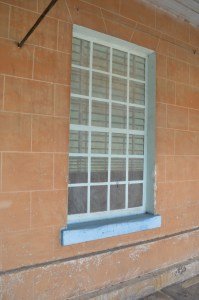
“Blind” windows featuring trompe l’oeil decoration. Photo credit: Ian Edmondson
As archaeologists we strive to read spaces and places more deeply, seeking evidence, signs and symbols to recreate a story of the past. Piddock describes institutional spaces in asylums as artefacts in themselves, not mere buildings (2007).
At a deeper level of reading we observe evidence of human occupation. The wear that is evident on steps from hundreds of feet ascending and descending gives clues to the common paths that people used, indicating areas of greater or lesser use. We imagine the feet that caused them and think about where they might have been coming from, or going to. We read the wear on door handles, hand-smoothed edges of window and door frames, observe changes in floorboards and note former exits, altered claddings and the age of fittings.
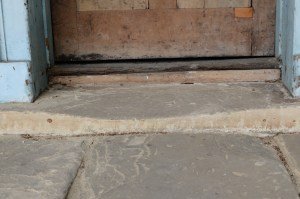
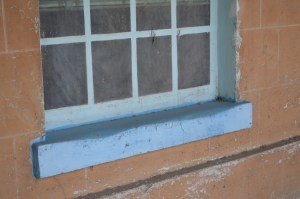
Use Wear… Stair, sill and doorstep wear from the Willow Court Barracks. Photo credit Ian Edmondson
On the false external window sills there are obvious marks of wear (presumably from resting bottoms), which show the importance of claiming private space in a public domain. Here is evidence that suggests occupants enjoying a conversation away from watching eyes, and perhaps avoiding being seen while doing it.
The pencil scribbling of letters and numbers on external walls tells a more personal story. They are not coherent words or expression of feelings, but signs and symbols of boredom, confusion, perhaps despair. They might also reflect moments of enjoyment or happiness, tucked into a warm, sheltered corner, claiming personal space.
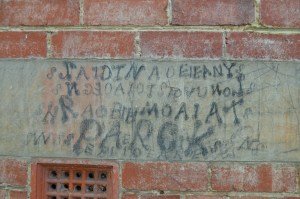
Written and numeric graffiti, Willow Court complex. Photo credit Ian Edmondson

Through reading buildings we can begin to appreciate the past experiences of those within them. Buildings, in their spatial arrangement, have the capacity shape social interaction, to order and structure human behavior, and to create or prevent social connections. Built environments have the power to condition how we think, feel and behave (Greenman 1988).
The Willow Court complex is sited in an elevated position within a beautiful river valley. Before we consider what lies under the ground, perhaps we need to read the broader aspect of its position and location and look outwards, to appreciate the beauty of the distant hills and trees, imagine the changing seasons, and see beyond the institutional spaces.

New Norfolk from Pulpit Rock Lookout: Photo Credit: JJ Harrison
References
Greenman, J. 1988 Caring Spaces, Learning Places: Children’s Environments That Work. Redmond, WA: Exchange Press.
Irving, R. 1985 The History and Design of the Australian House. Sydney: Oxford.
Piddock, S. 2007 A Space of Their Own: The Archaeology of Nineteenth Century Lunatic Asylums in Britain, South Australia and Tasmania. New York: Springer.
Solomon, R.J. 1976 Urbanisation: The Evolution of an Australian Capital. Sydney: Angus and Robertson.
Links
Willow Court History Group
Georgian Architecture: False, or “blind” windows
Georgian Architectural Style and Features

